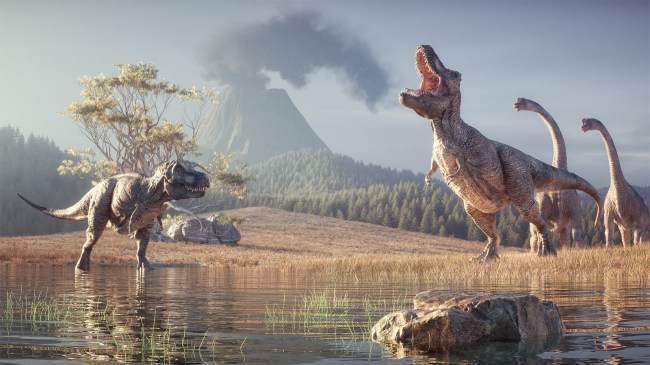iStockphoto
A team of paleontologists found more than 260 dinosaur footprints on opposite sides of the Atlantic Ocean that are similar in age, shape and geologic context.
These matching sets of dinosaur footprints in Africa and South America are believed to show proof that the creatures crossed from one continent to another 120 million years ago before they split apart.
“We determined that in terms of age, these footprints were similar,” said SMU paleontologist Louis L. Jacobs. “In their geological and plate tectonic contexts, they were also similar. In terms of their shapes, they are almost identical.”
The dinosaur footprints, which were impressed into mud and silt along ancient rivers and lakes, are now separated by 3,700 miles, but the continents now known as Africa and South America were once part of a single supercontinent called Gondwana.
“One of the youngest and narrowest geological connections between Africa and South America was the elbow of northeastern Brazil nestled against what is now the coast of Cameroon along the Gulf of Guinea,” Jacobs added. “The two continents were continuous along that narrow stretch, so that animals on either side of that connection could potentially move across it.”
Before the continental connection between Africa and South America was severed, “rivers flowed and lakes formed in the basins” Jacobs said. “Plants fed the herbivores and supported a food chain. Muddy sediments left by the rivers and lakes contain dinosaur footprints, including those of meat-eaters, documenting that these river valleys could provide specific avenues for life to travel across the continents 120 million years ago.”
“Dinosaur tracks are not rare, but unlike the bones usually found, footprints are the proof of dinosaur behavior, how they walked, ran or otherwise, who they walked with, what environment they walked through, what direction they were going, and where they were when they were doing it,” Jacobs told CNN.
Diana P. Vineyard, a research associate at SMU and co-author of the study, revealed that the footprints were created by three-toed theropod dinosaurs, and possibly some sauropods or ornithischians.
Jacobs says the fossilized dinosaur footprints were preserved in what is known as a half-graben basin that appears in both Brazil in South America as well as Cameroon in Africa.
“A half graben is an elongate basin formed by pulling apart of the Earth’s surface with a fault forming on one side such that the bottom of the valley tilts down toward the fault along which movement is occurring,” Jacobs stated. “Hold your hand in front of you. Tilt your fingers down, representing movement along the fault. Rivers will flow down the valley and deposit sediments and sediments will be eroded from the high side of the valley.”
Photos of the dinosaur tracks can be viewed here.

